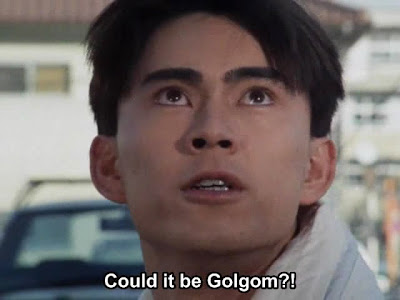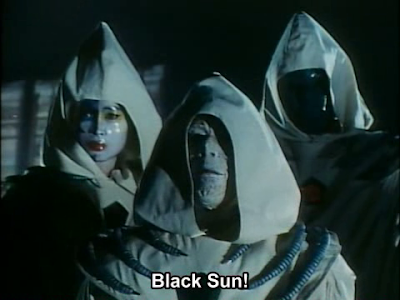Plot
Kamen Rider Fourze centers around the school days of punkadour-sporting Kisaragi Gentarou as he tries to make friends with everybody at Amanogawa High School, a place very much focused on space and science. One of his first challenges is befriending Utahoshi Kengo, a somewhat sickly student whose late father worked on utilizing mysterious space technology known as switches. Kengo isn't much of a fighter due to his poor physical condition, and he relunctantly lets Gentarou use the Fourze driver to power up and fight the Zodiart monsters that pop up at AGHS.
 |
| Fourze with Rocket and Drill switches activated. |
The interesting part is that the Zodiarts have their own switches, and are usually AGHS students that have been tempted to use the switches' powers by the enigmatic Horoscopes, higher-ups in the Zodiart chain of command. Gentarou and his ever-growing club of friends essentially save these stray students, defeating them to destroy the switches.
The first ten or so episodes focuses on Gentarou befriending the characters that come together to form the Kamen Rider Club. They have a sweet base on the moon (The Rabbit Hatch), linked by portal to a locker in a largely unused back room of the school. Kengo spends time at the Rabbit Hatch developing new switches for Fourze, based on his father's previous work.
Eventually, a new Rider shows up. Ryusei Sakuta transfers to AGHS, wielding the power to transform into Kamen Rider Meteor. He wishes to find the Aries Zodiart, as it may hold the key to reviving his comatose friend. Under orders from Tachibana, a masked benefactor from the Anti-Zodiart Alliance, Ryusei is to infiltrate the Kamen Rider Club. As a result, Meteor's identity remains a secret for quite some time. Of course, even Ryusei isn't any match for Gentarou's friending abilities, and they go from rivals to close allies over time.
 | |
| Your fate is mine to decide. |
Things escalate as Gamou, the leader of the Horoscopes, gathers the Horoscope switches for his sinister purposes. It's all pretty spoilerific, so I won't go into much detail.
Many early episodes of Fourze contain a combination of some of these events: New Zodiart appears, The Kamen Rider Club investigates, Fourze fights the Zodiart and saves the switch user, Gentarou befriends someone (often the switch's user, even). As previously mentioned, the first ten or so revolve around the students that join the Kamen Rider Club, so there's a lot of time devoted to getting the KRC set up, making it take a while for the plot to really take off.
Overall, the plot can be a bit formulaic, but that's fairly normal for toku. Things get serious toward the end, but I couldn't help but feel that it was a bit rushed. The series is also not quite 50 episodes. I bet if they had a few more episodes or better utilized some of the less plot-driving episodes, the pacing would feel a bit more even. I was a tad disappointed in the ending. It seemed too...familiar in some ways, and it wasn't quite the epic conclusion I was looking for.
Characters
Fourze has a large and interesting cast of characters. The Kamen Rider Club seems to double as both a strength and a weakness for the show. The interactions between the KRC members is enjoyable, but because of the larger cast, less time can be spent on individual character development.
Gentarou is an interesting lead. His absurdly friendly attitude combined with his carefree, punkish look give him a distinctive feel. He stands out quite well among the other Kamen Rider protagonists. All of his actions seem to be motivated by friendship. It's quite literally his source of power, as can be seen when Fourze's Cosmic States form debuts. Gentarou doesn't have much of a background story, other than the fact that he lives with his grandfather, who is a goofball much like he is. His development revolves around the friendships he builds with everybody else, but by himself, he's not terribly deep.
Kengo and Jojima Yuki are arguably the most important of the Kamen Rider Club characters. Kengo builds a slow and reluctant friendship with Gentarou, but it becomes very strong later on. He is the at the center of quite a few important plot developments. Yuki is a goofy trainwreck of a girl, but is Gentarou's only friend at AGHS when the show starts. She's obsessed with space and can be seen prancing around with her Hayabusa plush. She's cute, especially when she mimics Fourze's transformation and poses, but she can also be annoying at times.
We also have Tomoko, the weird goth girl. Scenes with her are usually pretty entertaining, and sometimes she even emits a tangible, creepy aura. She's one of my favorite KRC members, and later seems to possibly have a bit of a thing going on with Ryusei/Meteor, but nothing really becomes of it on-screen. Her keen insights help the KRC on several occasions. There's also Miu, the bossy cheerleader and Queen of AGHS, who takes somewhat of a leadership position over the Kamen Rider Club.
 |
| Tomoko during one of her creepy moments. |
 |
| Tomoko's reaction to people seeing her without makeup. |
 |
| Honestly, she's quite attractive. |
Anyway, enough Tomoko pics.
Of course, there are more KRC members, including Shun, the football player and King of AGHS. He is portrayed as the typical jock at first, but turns into a useful member of the KRC, piloting the Power Dizer to help Fourze knock some sense into the Zodiarts. Last but not least is JK, a cowardly, yet stylish guy that seems to know just about everybody. The guy has some trust and friendship issues, but he is useful for digging up information.
 |
| Miu and JK. |
Of course, Ryusei (Kamen Rider Meteor) later joins the gang. He quite a prick at first, pretending to be a quiet transfer student to weasel his way into the KRC while actually being a spy. He finds himself at odds with Gentarou and even fights him sometimes in order to accomplish his own goals/purposes. Eventually, his identity as Meteor is revealed (in epic fashion). Gentarou shows Ryusei the ways of friendship, and they become close allies, with the KRC accepting him with open arms.
 |
| Ryusei's typical look of mild annoyance. |
And that's just the Kamen Rider Club. Most of the big villains are actually school faculty or administrators, though a student or two become Horoscopes as well. Some of the teachers are good guys, though. Mr. Ohsugi, for example, is a good-hearted guy that serves as comic relief (as if the show really needs it). Almost every scene he is in is absurdly goofy, and he isn't terribly helpful.
 |
| Poor, heartbroken Ohsugi. |
Overall, Fourze has likable characters, but perhaps too many of them. When every KRC member gets a story arc or two to themselves, you can imagine how many episodes it takes up. This kind of thing sometimes happens in Sentai shows where each of the characters gets rotated development arcs for awhile, sometimes resulting in the character development getting spread a bit thin.
Fights/Visuals/Music
The fights are one of the best things about Fourze. Gentarou has a clumsy way of fighting that is entertaining to watch. However, he makes up for his poor fighting technique by utilizing Fourze's many switches. Gentarou ends up with many switches at his disposal, and he utilizes some interesting combinations. However, the "regular" switches get neglected a bit as he obtains Electric, Fire, Magnet, and Cosmic States. There are so many possibilities and combinations, but Fourze's powers get handled poorly as Gentarou later spams the abilities of Fourze's alternate states.
 | |
| Fourze Cosmic States |
Ryusei, on the other hand, is quite the martial artist. He goes full Bruce Lee mode, complete with "Wacha!" sounds. Unfortunately, like with Fourze, Meteor's powers are handled poorly, in my opinion. He has some nifty planet powers that he can imbue his fist with, but he uses them only at first, and they seem to mostly be forgotten later for some reason. Meteor actually isn't around too long before he get his upgraded form, Meteor Storm, which utilizes a rod with a beyblade-like top attachment that he can fling at enemies. Honestly, I think the Meteor Storm form is pretty ugly.
 |
| Meteor Storm |
Some Kamen Rider fans were repulsed at the suit designs for Fourze. I admit that they were a bit odd at first, but I grew to like Fourze and Meteor's base forms in particular. Fourze's alternate forms are okay, though Cosmic States is easily the coolest. The Zodiart designs are rather cool as well.
The special effects are fairly solid throughout the series. There are quite a few space scenes and battle effects that make heavy use of CG, but overall, it is done well (for toku), at least in comparison to some of the earlier Heisei Kamen Rider shows.
The music in Fourze is pretty good and feels appropriate. The BGM utilizes an upbeat, electronic feel, though I can't say that many BGM tracks stand out to me. The opening is fun and catchy, but the ending themes were hit or miss for me me. Giant Step and Cosmic Mind are easily my favorite picks.












































